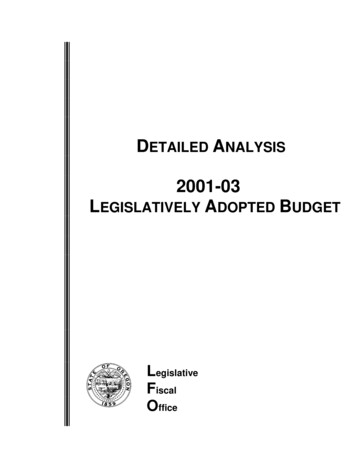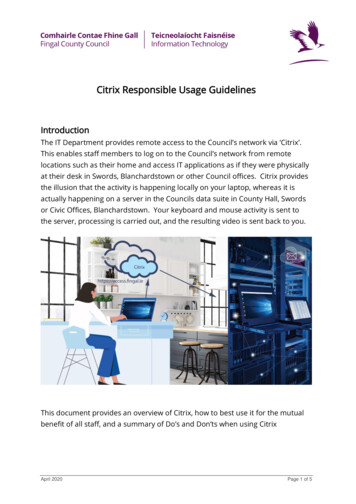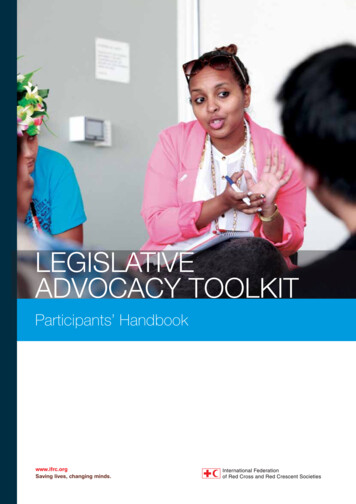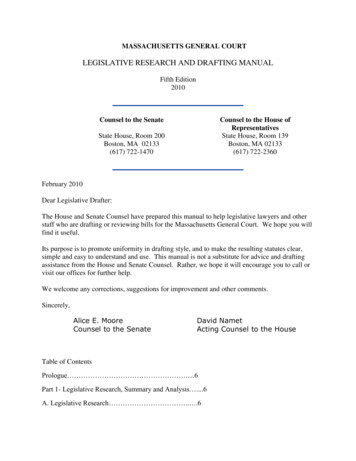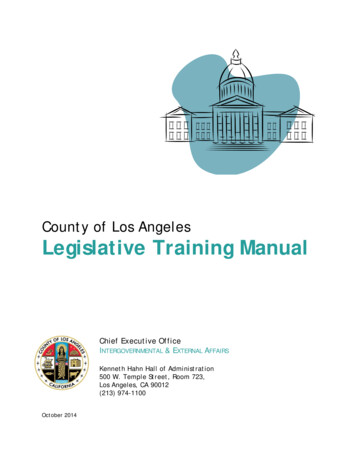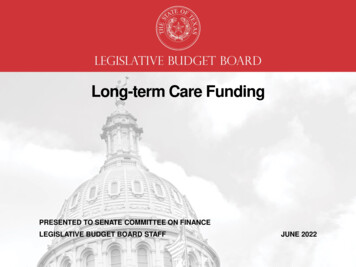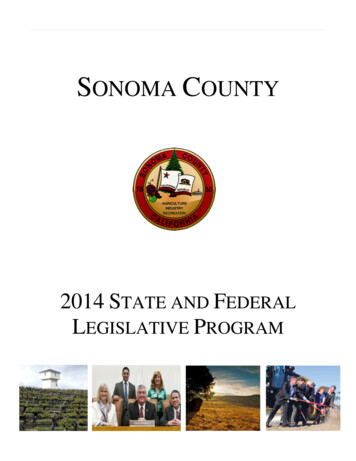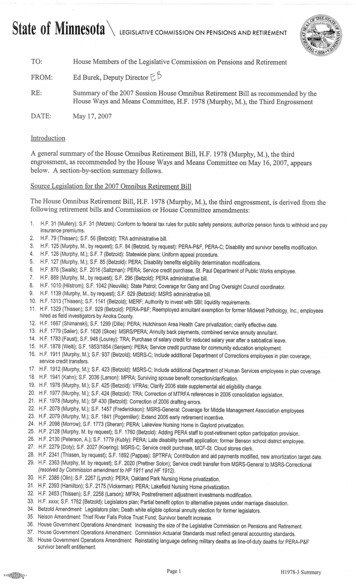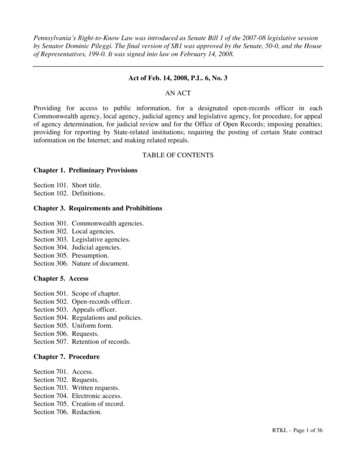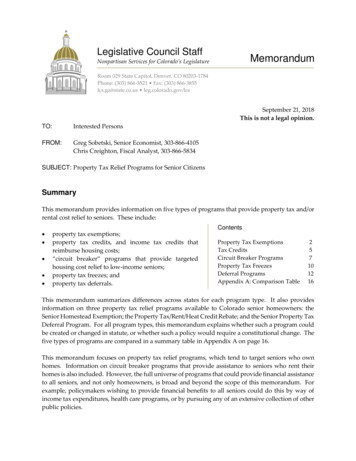
Transcription
Legislative Council StaffMemorandumNonpartisan Services for Colorado’s LegislatureRoom 029 State Capitol, Denver, CO 80203-1784Phone: (303) 866-3521 Fax: (303) 866-3855lcs.ga@state.co.us leg.colorado.gov/lcsSeptember 21, 2018This is not a legal opinion.TO:Interested PersonsFROM:Greg Sobetski, Senior Economist, 303-866-4105Chris Creighton, Fiscal Analyst, 303-866-5834SUBJECT: Property Tax Relief Programs for Senior CitizensSummaryThis memorandum provides information on five types of programs that provide property tax and/orrental cost relief to seniors. These include: Contentsproperty tax exemptions;property tax credits, and income tax credits thatreimburse housing costs;“circuit breaker” programs that provide targetedhousing cost relief to low-income seniors;property tax freezes; andproperty tax deferrals.Property Tax ExemptionsTax CreditsCircuit Breaker ProgramsProperty Tax FreezesDeferral ProgramsAppendix A: Comparison Table257101216This memorandum summarizes differences across states for each program type. It also providesinformation on three property tax relief programs available to Colorado senior homeowners: theContentsSenior Homestead Exemption; the Property Tax/Rent/Heat Credit Rebate; and the Senior Property TaxDeferral Program. For all program types, this memorandum explains whether such a program couldNo table of contents entries found.be created or changed in statute, or whether such a policy would require a constitutional change. Thefive types of programs are compared in a summary table in Appendix A on page 16.This memorandum focuses on property tax relief programs, which tend to target seniors who ownhomes. Information on circuit breaker programs that provide assistance to seniors who rent theirhomes is also included. However, the full universe of programs that could provide financial assistanceto all seniors, and not only homeowners, is broad and beyond the scope of this memorandum. Forexample, policymakers wishing to provide financial benefits to all seniors could do this by way ofincome tax expenditures, health care programs, or by pursuing any of an extensive collection of otherpublic policies.
This memorandum relies on information from the Significant Features of the Property Tax database,which aggregates property tax policy information from across the United States.1 The database ismaintained by the Lincoln Institute of Land Policy and the George Washington Institute of PublicPolicy.Property Tax ExemptionsProperty tax exemptions, also called homestead exemptions, are a common means of providing directproperty tax relief to senior homeowners. As of 2016, these programs were available to seniorresidents in 21 states.2 A property tax exemption reduces the value of the property that is subject totaxation, or exempts the property from taxation altogether. This section provides comparisons ofexemption amounts and eligibility criteria across the states that offer property tax exemptions tosenior homeowners.Amount exempted. Property tax exemptions may be applied in absolute dollar amounts or as apercentage of a home’s value. Colorado’s senior homestead exemption, which exempts 50 percent ofthe first 200,000 of a home’s actual value, is a hybrid of these two types. Share of value. Of the 21 states that offered property tax exemptions for seniors in 2016, fivestates,3 including Colorado, exempted a percentage of a home’s value from taxation. Among thesestates, Alabama and Georgia exempt the entire value of senior homeowners’ primary residencesfrom their state property taxes while allowing smaller exemptions calculated in absolute dollaramounts from property taxes levied by local governments and school districts.4 Indiana allowsan exemption equal to 50 percent of a property’s assessed value up to a cap of 12,480.5North Carolina allows an exemption equal to 50 percent of a property’s entire assessed value, andno less than 25,000.6 Absolute dollar amount. States that offer exemptions according to absolute dollar amounts varyaccording to whether these exemptions are applied to a property’s market value or assessed value.These exemptions range from market values of 25,000 in Ohio7 to at least 150,000 in Alaska.8However, without considering the mechanics of each state’s property tax system, includingvaluation, assessment rates, and mill levies, it is difficult to evaluate or compare the monetarybenefit they provide to senior bcenters/significant-features-property-tax/Report Residential Property Tax Relief Programs.aspx2Alabama, Alaska, Colorado, Connecticut, Delaware, Florida, Georgia, Hawaii, Illinois, Indiana, Massachusetts,Mississippi, New Hampshire, New York, North Carolina, Ohio, South Carolina, Texas, Virginia, Washington, andWest Virginia.3Alabama, Colorado, Georgia, Indiana, and North Carolina.4Ala. Code § 40-9-19; Ga. Code Ann. § 48-5-48.3.5Ind. Code § 6-1.1-12-9 (b).6N.C. Gen. Stat. § 105-277.1.7Ohio Rev. Code § 323.152 (A)(1)(c).8Alaska Stat. § 29.45.030 (e).2
Changes in the value of benefits over time. Property tax exemptions provide a financial benefit tosenior homeowners by reducing the amount of taxes they owe. As the value of real estateincreases, a percentage exemption will provide a more persistent benefit over time than anabsolute dollar amount benefit, assuming that the absolute dollar amount is not adjusted forchanges in property values or inflation. However, if the percentage exemption does not exemptthe entire property value from taxation, the property tax burden on senior homeowners will stillincrease as home values appreciate.Eligibility requirements. Eligibility requirements differ significantly across states, and include incomeor wealth, residency, and age requirements as described below. Income requirements. Of the 21 states allowing property tax exemptions for senior citizens in 2016,13 states9 imposed an income requirement for at least a portion of the exemption. The other eightstates, including Colorado,10 do not impose income requirements. The income caps imposed varysignificantly by state. For example, Delaware allows a property tax exemption for seniors whoseincome is less than 3,000, or 6,000 for married couples.11 At the high end of the spectrum,eligibility for a school district property tax exemption is restricted to New York seniors withincomes under 86,000.12 Ohio’s income cap was added to its senior property tax exemption in2013, and seniors who had qualified prior to this date are exempt from the cap.13 Virginia allowsincome constraints to be set at the local level, with local governments bearing the impacts ofreduced property tax revenue resulting from the local exemption.14 Wealth requirements. Wealth requirements, based on the value of a homeowner’s property, wereidentified in three states. In Massachusetts and New Hampshire, a homeowner is eligible for aproperty tax exemption only if the value of his or her real and personal property falls below acertain threshold. The threshold excludes the value of the home itself and is 17,000 inMassachusetts ( 20,000 if married),15 and determined by local governments in New Hampshire.16Indiana’s property tax exemption is only available for homes with an assessed value of less than 182,430.17 Residency requirements and portability. Most states, including Colorado, allow property taxexemptions only for a senior’s primary residence. Seven states18 impose additional residencyrequirements, whereby seniors only qualify for all or a portion of the property tax exemption ifthey have resided in the state or in their home for a defined period of time. Colorado’s ten-yearresidency requirement19 is the strictest among states that offered a property tax exemption to9Alabama,Delaware, Florida, Georgia, Hawaii, Indiana, Massachusetts, New Hampshire, New York, North Carolina,Ohio, Virginia, and Washington.10Alaska, Colorado, Connecticut, Illinois, Mississippi, South Carolina, Texas, and West Virginia.11Del. Code tit. 9, § 8132 (a).12N.Y. R.P.T. Law § 425.13Ohio Rev. Code § 323.152 (A)(2); see also Ohio House Bill 59 (2013).14Va. Code Ann. § 58.1-3210.15Mass. Gen. Laws ch. 59, § 5-41.16N.H. Rev. Stat. Ann. § 72: 39-b (II).17Ind. Code § 6-1.1-12-9 (a)(5).18Colorado, Delaware, Indiana, Massachusetts, New Hampshire, New York, and West Virginia.19Colo. Const. art. X, § 3.5 (1)(a).3
seniors in 2016. The next-strictest requirement is in Massachusetts, which allows a 4,000exemption to seniors who have resided in the state for at least five years.20In some states, seniors who move are able to apply the property tax exemption to their new home.Residency provisions in other states, including Colorado, require that seniors live in their newhome for a certain period of time before they become eligible for the exemption again. Age requirements. This analysis concerns only property tax benefits offered specifically to seniorhomeowners, though many states, including Colorado, offer property tax relief programs tohomeowners who meet other criteria independent of age. Among the states with property taxexemption programs for seniors, 18 states, including Colorado, made programs available tohomeowners aged 65 and older. Some Hawaii residents are eligible at 60;21 Washington residentsare eligible at 61;22 and Massachusetts residents are eligible at 70.23 Non-homeowners. Seniors who do not own their homes do not directly benefit from property taxexemptions.Budget impacts for governments. Government impacts vary from state to state depending on thetaxing authority and the government entity that bears the loss in property tax revenue. Colorado hasno state property tax, so Colorado’s senior homestead exemption reduces tax payments to localgovernments. However, the constitution requires that the state reimburse local governments for theproperty tax loss, so the ultimate budgetary impact of Colorado’s program is borne by the state.24Other states incur state and/or local revenue loss according to their own circumstances.Constitutional vs. statutory requirements. Provisions related to senior property tax exemptionsappear in the constitutions of 5 of the 21 states identified. In Virginia and Washington, constitutionallanguage is permissive, allowing the state legislature to create a senior property tax exemption at itsdiscretion.25 In Colorado, Texas, and West Virginia, the state constitution dictates the availability ofspecific senior property tax exemptions.26Application in Colorado. Colorado’s senior homestead exemption is available to seniors aged 65 andabove, or surviving spouses, who have resided in their home for at least ten years, and applies to50 percent of a home’s market value up to 200,000. The constitution allows the General Assembly toadjust the 200,000 limit in order to increase or decrease the benefit available to senior homeowners.Adding or removing eligibility requirements – e.g., imposing an income ceiling or reducing theresidency requirement – likely requires a constitutional change. Similarly, Article X, Section 3 (1)(a)of the Colorado Constitution, which requires uniform taxation of residential properties, likelyprecludes the creation of a new property tax exemption without a constitutional amendment.20Mass.Gen. Laws ch. 59, § 5-41.property tax exemption is not administered at the state level, but exemptions that apply at age 60 have beenenacted at the county level for the islands of Hawaii and Kauai.22Wash. Rev. Code § 84-36-381 (3)(a)(i).23Mass. Gen. Laws ch. 59, § 5-41.24Colo. Const. art. X, § 3.5 (3).25Va. Const. art. X, § 6 (b); Wash. Const. art. VII, § 10.26Colo. Const. art. X, § 3.5; Tex. Const. art. VIII, § 1-b (c); W. Va. Const. art. X, § 1b (C).21Hawaii’s4
Tax CreditsTax credits are dollar-for-dollar reductions in the amount of tax owed. As of 2016, these programswere available to senior homeowners in 11 states27 and the District of Columbia. Depending on thestate, tax credits may be applied directly against a homeowner’s property tax bill, such that theamount of tax due is reduced. Alternatively, tax credits may be made available on a homeowner’sincome tax form, such that the homeowner receives an income tax benefit based on his or her propertytax liability. Allowing senior homeowners to claim an income tax credit for a portion of the propertytax they paid can be an effective way of shifting the budget burden of the property tax relief programfrom local governments to the state government, provided that the state imposes an income tax.Tax credits by type. The following paragraphs provide information on four types of property taxcredits: dollar-for-dollar credits, local option credits, credits that operate like exemptions, and creditsthat operate like freezes. Dollar-for-dollar credits. Three states offer tax credits that reduce a senior homeowner’s propertytax liability on a dollar-for-dollar basis. New Jersey’s credit is the most straightforward, equal to 250 for senior homeowners with incomes less than 10,000.28 Massachusetts allows the morevaluable of a 175 credit or 2,000 exemption to senior homeowners whose assets fall below itswealth limit.29 Mississippi offers credits from 6 to 300 in 50 brackets according to the assessedvalue of the property in question following a table in statute.30 Local option credits. Illinois and Maryland allow municipal governments to provide propertytax credits to senior homeowners.31 Maryland also extends this authorization to countygovernments, and allows both counties and municipalities to provide property tax credits toproperty lessors who rent housing to senior lessees.32 Credits that operate like exemptions. Four states33 and the District of Columbia offer tax creditsthat operate like property tax exemptions. The credits offered by these jurisdictions are equal tothe amount of property tax paid on a portion of a home’s value, effectively exempting that portionof the home from taxation. Two states offer credits equal to the tax paid by low-incomehomeowners on a specific amount of a home’s market value: 27,000 in Tennessee and 20,000 inexcess of the amount of the property tax exemption in West Virginia.34 Delaware, Kansas, and theDistrict of Columbia allow credits equal to the property tax paid on a percentage of the property,ranging from 50 percent of school district taxes paid, up to 500, in Delaware35 to 75 percent forKansas homeowners with income less than 120 percent of the federal poverty level.3627Delaware,Kansas, Illinois, Indiana, Maryland, Massachusetts, Mississippi, New Jersey, Tennessee, Texas, andWest Virginia.28N.J. Rev. Stat. § 54: 4-8.41.29Mass. Gen. Laws. Ch 59, § 5-17.30Miss. Code Ann. § 27-33-75.3165 Ill. Comp. Stat. § 75/1; Md. Code, Tax – Property § 9-245.32 Md. Code, Tax – Property § 9-219.33Delaware, Kansas, Tennessee, and West Virginia.34Tenn. Code Ann. § 67-5-702; W. Va. Code § 11-21-21.35Del. Code tit. 14, § 1917 (c)(1)(b).36Kan. Stat. Ann. § 79-32,263.5
Credits that operate like freezes. Three states37 offer tax credits that control growth in ahomeowner’s property tax liability, similar to a property tax freeze. For senior homeowners whomeet New Jersey’s income and residency requirements, and for school district taxes owed by allTexas senior homeowners, state tax credits reduce tax liability such that the amount a senior oweseach year does not increase as the value of the senior’s home appreciates.38 The senior tax creditin Indiana operates to limit growth in a senior homeowner’s property tax liability to no more than2 percent per year, with caps on an eligible senior’s income ( 30,000, or 40,000 if married) andhome value ( 160,000).39 Changes in the value of benefits over time. Tax credits provide a financial benefit to seniors byreducing the amount of property or income taxes they owe. As the value of real estate increases,a credit that operates like a property tax freeze will most effectively control rising property taxes.Credits that refund the amount of tax paid on a percentage of the property will provide a morepersistent benefit over time than an absolute dollar amount credit, unless the absolute dollaramount is adjusted for changes in property values.Eligibility requirements. Eligibility requirements differ significantly across states. Residency requirements and portability. In some states, seniors who move are able to access a taxcredit immediately after moving. Residency provisions in other states, like New Jersey, requirethat seniors live in their new home for a certain period of time before they become eligible for thecredit again. Credits that operate like freezes are designed to control the growth in property taxesowed on a particular residence, and do not provide a benefit to seniors who move to a new home. Non-homeowners. Tax credits for homeowners who pay property tax do not directly benefitnon-homeowners. Maryland provides a credit to lessors who rent homes to seniors, which mayincent landlords to seek senior tenants or reduce rents offered to them.Budget impacts for governments. Tax credits reduce the amount of tax revenue that a governmentwould otherwise collect. Credits that directly reduce property taxes may reduce county, municipal,school district, special district, or state revenue. Credits that appear on income tax forms generallyreduce state revenue.The ongoing budgetary impact of a tax credit for senior homeowners depends on the specifics of thepolicy. All credits will grow in size as more seniors qualify, but growth in the budget impact may beslower in states that offer a fixed dollar credit and larger in states that offer a percentage credit or acredit that operates like a property tax freeze.Application in Colorado. Article X, Section 3 (1)(a) of the Colorado Constitution, which requiresuniform taxation of residential property, likely precludes the creation of a direct property tax creditwithout a constitutional change. The General Assembly is empowered to create a state income taxcredit that is sensitive to the amount of property tax paid by senior homeowners to local governments.If such a program were created, the General Assembly could choose to impose age, income, or37Indiana,New Jersey, and Texas.Rev. Stat. § 54: 4-8.69 (2); Tex. Tax Code § 11.26.39Ind. Code § 6-1.1-20.6-7.5.38N.J.6
residency constraints at its discretion, and could impose a cap on the total amount of tax creditsallowed. Administrative costs would likely be higher than for other tax credits, as the Department ofRevenue would need to verify property tax information with the appropriate county assessor ortreasurer.Circuit Breaker ProgramsAs of 2016, 28 states40 and the District of Columbia offered senior property tax relief programs that areinversely related to a homeowner’s income, and available only to homeowners whose incomes fallbelow a certain threshold. This type of program is commonly called a “circuit breaker” becauseeligibility for the program switches off at a certain level of income.This section provides information on circuit breaker program characteristics, including incomeceilings, benefit caps, benefit types, and assistance to property renters. It also provides informationon Colorado’s Property Tax/Rent/Heat Credit Rebate (PTC Rebate) program, which is a circuit breakerproperty tax relief program available to Colorado seniors.Eligibility requirements and benefit structure. Circuit breaker programs are structured differentlyacross the states that offer them. Residency requirements and portability. Most circuit breaker programs are available to seniorhomeowners and/or renters regardless of the amount of time for which they have resided in theirhomes. North Carolina’s circuit breaker program, which is available only to seniors who haveresided in their home for five years, is an exception.41 Colorado’s PTC Rebate program is availableto seniors who have resided in their homes for the full year. Non-homeowners. Relative to other forms of property tax relief, circuit breaker programs aremore frequently available to seniors who rent their homes. Nineteen states42 and the District ofColumbia offered circuit breaker programs to both senior homeowners and senior renters in 2016.Renter benefits are often structured based on the assumption that a percentage of rent paid is spentby the landlord on property tax. For example, Wisconsin’s circuit breaker property tax creditstatute defines “rent constituting property taxes accrued” to equal 25 percent of rent paid, or20 percent if heating costs are included in the rent.43 Wisconsin computes its property tax reliefbenefit as a percentage of this amount. Income ceilings. In all states, the value of circuit breaker programs is greatest for eligible recipientswith the lowest incomes and diminishes as incomes rise. States establish income ceilings abovewhich taxpayers are no longer eligible to access benefits. The level at which the income ceiling isset is the most important determinant of the program’s size and budget impact, as states with high40Arizona,California, Colorado, Connecticut, Idaho, Iowa, Kansas, Maine, Maryland, Massachusetts, Michigan,Missouri, Montana, Nebraska, Nevada, New Jersey, New Mexico, North Carolina, North Dakota, Oklahoma,Pennsylvania, Rhode Island, South Dakota, Utah, Washington, West Virginia, Wisconsin, and Wyoming.41N.C. Gen. Stat. § 105-277.1B (d)(2).42Arizona, California, Colorado, Iowa, Maine, Maryland, Massachusetts, Michigan, Missouri, Montana, Nevada,New Mexico, North Dakota, Pennsylvania, Rhode Island, Utah, West Virginia, Wisconsin, and Wyoming.43Wis. Stat. § 71.52 (8).7
ceilings will allow benefits to a greater population than states with low ceilings. Income ceilingsvary widely, from 5,000 in West Virginia44 to 200,000 in New Jersey.45 Benefit caps. Most states cap the annual amount of property tax relief provided to an individualtaxpayer via their circuit breaker program. Annual cap amounts vary widely across states, from 93.75 in West Virginia46 to 2,000 in New Jersey.47 Colorado’s benefit is capped at 700.48 Benefit types. Four types of property tax relief provided through state circuit breaker programsare described in the following paragraphs. Regardless of the benefit type, benefits may beprovided to taxpayers as a direct reduction in the amount of property tax due, as an income taxcredit or other direct cash transfer on an income tax form, or via some other transfer mechanism.–Percentage of tax paid. Nine states49 use circuit breaker programs to reduce property tax due bysome percentage, or to provide a rebate for a percentage of property tax paid. For example,Connecticut’s circuit breaker program is available to seniors whose income is less than 35,300,or 43,000 if married, for 2017.50 Depending on where qualifying homeowners fall within fiveincome brackets, the state allows a benefit of between 10 percent (in the highest incomebracket) and 50 percent (in the lowest income bracket) of property tax paid, up to a maximumof 1,000 for single homeowners and 1,250 for married homeowners.51 Percentage benefitsoffered by states range from 5 percent of taxes paid by Kansas homeowners with incomesbetween 26,001 and 34,45052 to 100 percent of property taxes paid by Iowa homeowners withincomes under 11,774.53–Benefits for tax paid in excess of a percentage of income. Eight states54 and the District of Columbiause circuit breaker programs to reduce property tax to some percentage of a homeowner’sincome, or to provide a rebate for property tax paid in excess of such a percentage. Forexample, Montana provides a tax credit equal to the amount by which a homeowner’sproperty tax liability exceeds a certain threshold, computed as a percentage of the taxpayer’shousehold income.55 For taxpayers with income less than 2,000, this threshold is zero,effectively eliminating the taxpayer’s property tax liability. For taxpayers with income lessthan 3,000, this threshold is 0.6 percent of household income, effectively limiting propertytaxes owed to no more than 18. For taxpayers with income between 12,000 and 35,000, thethreshold is 5 percent, effectively limiting property taxes to 1,750 for taxpayers earning44W.Va. Code § 11-25-3 (a)(6).Rev. Stat. § 54: 4-8.59 (3)(b)(1).46W. Va. Code § 11-25-3 (a)(1) and (b).47N.J. Rev. Stat. § 54: 4-8.59 (3)(a).48Section 39-31-101, C.R.S.49California, Connecticut, Iowa, Kansas, Maine, New Jersey, South Dakota, West Virginia, and Wisconsin.50Connecticut Homeowner Question & Answer Booklet van/owners q&a 2018.pdf51Conn. Gen. Stat. § 12-170bb.52Kan. Stat. Ann. § 75-4508; Kansas Homestead or Property Tax Refund for Homeowners (2017), p. owa Code § 425.23; Iowa Property Tax Credit Claim ryland, Massachusetts, Michigan, Montana, New Mexico, North Carolina, Oklahoma, and Rhode Island.55Mont. Code Ann. § 15-30-2340 (4).45N.J.8
35,000. Thresholds of this type range from zero for Montana seniors with very low incomesto 10 percent for senior homeowners in Massachusetts.56 –Flat benefits. Eight states57 use circuit breaker programs to provide property tax relief orreimbursements to seniors using flat dollar amounts depending on the senior homeowner’sincome. In these states, the amount of the benefit falls as the homeowner’s income rises. Forexample, Idaho offers relief of 1,320 to taxpayers with incomes under 12,090, and a smallerbenefit to senior homeowners with higher incomes. Idaho has 36 brackets in all with thesmallest amount, 150, provided to taxpayers with incomes between 29,521 and 30,050 for2018.58–Circuit breaker property tax exemptions. Three states59 use circuit breaker programs to offerproperty tax exemptions. These circuit breakers are similar to programs in other states butprovide property tax relief via an exemption of a home’s value, rather than a tax credit orrebate. For example, for 2018, Nebraska offers an exemption equal to 100 percent of the valueof a senior homeowner’s primary residence if his or her income falls below 28,200. The valueof the exemption diminishes as income rises, and equals 10 percent of property value forseniors with incomes between 39,901 and 41,400. The exemption is not available for seniorswith incomes over 41,400.60Changes in the value of benefits over time. Circuit breaker programs provide a financial benefitto senior homeowners with low incomes, but may provide a diminished benefit or no benefit tosenior homeowners with high incomes. Precise benefits vary according to the state that authorizesthe program. Some state circuit breaker programs, including Colorado’s PTC Rebate program,are available only to seniors with very low incomes.Over time, the financial benefit of circuit breaker programs will diminish unless they arecalculated as a percentage amount or adjusted for inflation. Additionally, programs whoseeligibility requirements are not adjusted for inflation will be made available to fewer seniors asincomes rise over time.Budget impacts for governments. Relative to other property tax relief programs, circuit breakers cancontrol costs for governments by reducing the population that is eligible for a benefit, and by reducingbenefits to higher income seniors within the eligible population. However, government revenuelosses or expenses associated with circuit breaker programs are counter-cyclical, meaning that theymount during economic downturns when government budgets are tightest.Over time, the impact of circuit breakers will grow more quickly if eligibility thresholds and benefitlevels are inflation-adjusted, and will grow less quickly or potentially fall if these amounts are notinflation-adjusted.56Mass.Gen. Laws ch. 62, §6 (k)(2).Colorado, Idaho, Missouri, Nevada, Pennsylvania, Utah, and Wyoming.58Idaho Code Ann. § 63-704; Idaho Property Tax Reduction Income Brackets (2018).https://tax.idaho.gov/pubs/EPB00168 10-02-2017.pdf59Nebraska, North Dakota, and Washington.60Neb. Rev. Stat. § 77-3507; Nebraska Homestead Exemption Information Guide .pdf57Arizona,9
Application in Colorado. Colorado’s PTC Rebate program is a circuit breaker property tax reliefprogram similar to those in other states. For 2017, the PTC Rebate is available to Colorado seniorswith incomes of less than 13,608 ( 18,343 married filing jointly), provided that they paid propertytax, rent, or heating bills.61 The maximum amount of the rebate is 700. This amount may be reducedfor an individual senior according to the amount by which the senior’s income exceeds aninflation-adjusted threshold equal to about half of the individual income ceiling.In FY 2016-17, the Department of Revenue issued PTC Rebates to 44,343 low-income Coloradans,primarily senior homeowners and renters. Surviving spouses of qualifying seniors, and persons whoare disabled for the entirety of the tax year, are also eligible. Rebates totaled 6.0 million and averaged 136 per recipient, paid from the state General Fund.62Because this program is a statutory expenditure, the General Assembly has the authority to change itas it deems appropriate. The program was most recently expanded in Senate Bill 14-014, whichincreased the size of the maximum rebate from 600 to 700, added inflation adjustments for incomethresholds, and implemented audit recommendations.Property Tax FreezesAs of 2016, 11 states offered a property tax freeze to senior homeowners.63 Homeowners who areeligible for these programs pay property tax as if the value of their home were frozen, or unchanged,at a certain point in time. “Freeze” programs provide benefits to homeowners as the market value oftheir homes appreciate because homeowners do not pay taxes associated with the increase in value.The following section provides information on property tax freeze
Nonpartisan Services for Colorado's Legislature Room 029 State Capitol, Denver, CO 80203-1784 Phone: (303) 866-3521 Fax: (303) 866-3855 lcs.ga@state.co.us leg.colorado.gov/lcs Memorandum September 21, 2018 This is not a legal opinion. TO: Interested Persons FROM: Greg Sobetski, Senior Economist, 303-866-4105
